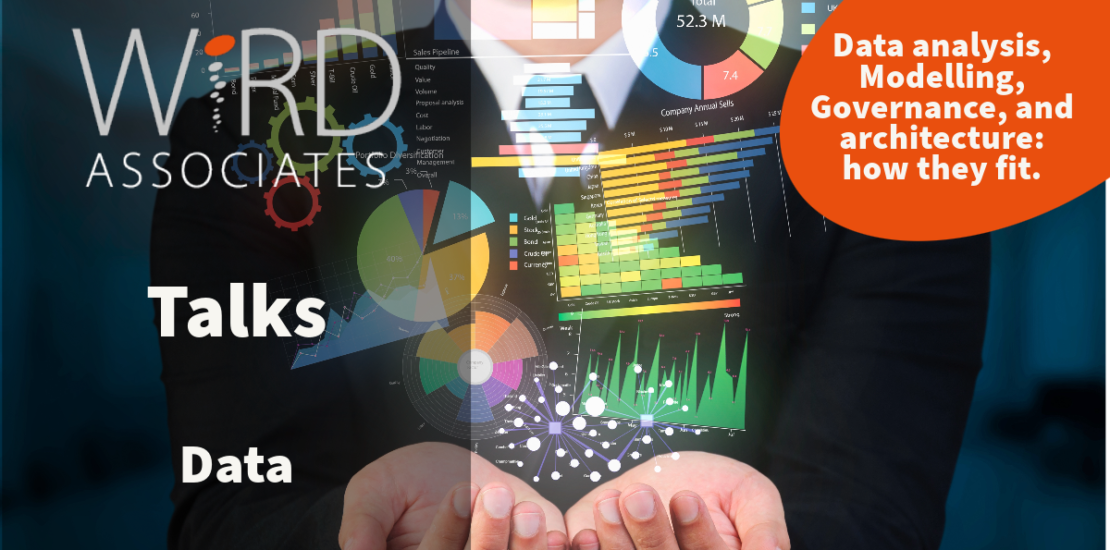- 2023-09-13
- Posted by: Colleen Greeff
- Categories: Data, IT Architecture

In the ever-evolving landscape of today’s data-driven world, the synergy between data analysis, modelling, governance, and architecture has become a critical endeavour for organizations striving to thrive and innovate. At WiRD we have attempted to unravel the intricate web of these four interconnected pillars that underpin the successful utilization of data over the last while on our blog. In this digital age, understanding how these components work in tandem is essential for businesses seeking to harness the full potential of their data assets. Whether you’re a seasoned data professional or a curious newcomer, join us as we delve deep into the fascinating realm where data analysis, modelling, governance, and architecture converge, exploring their symbiotic relationship.
Data analysis is the systematic process of examining, cleaning, transforming, and interpreting data to extract meaningful insights and inform decision-making. It involves using various statistical, mathematical, and computational techniques to discover patterns, trends, and relationships within datasets. Data analysis is employed across diverse fields, from business and finance to healthcare and research, to make informed choices, solve problems, and gain a deeper understanding of phenomena. It often involves the use of software tools and programming languages to process and visualize data, making it accessible and actionable for individuals and organizations aiming to derive value and knowledge from their data assets.
Data modelling is a structured process of defining and organizing data to represent the real-world entities, relationships, and attributes within a database or information system. It serves as a blueprint that helps design and manage data effectively. In essence, data modelling helps answer critical questions about how data should be stored, accessed, and manipulated within an organization. By creating a visual representation of data elements and their relationships, data modelling not only enhances data understanding but also aids in database design, development, and maintenance, ultimately supporting more efficient and accurate data management and analysis. It is a fundamental practice in information technology, facilitating data-driven decision-making and the development of robust database systems.
Data governance is a framework and set of practices that ensure the consistent, secure, and responsible management of an organization’s data assets. It encompasses policies, procedures, and guidelines that define how data is collected, stored, accessed, and used. The primary goals of data governance are to maintain data quality and integrity, protect sensitive information, and ensure compliance with regulatory requirements. It also establishes roles and responsibilities for data management, promoting transparency and accountability throughout the data lifecycle. Effective data governance not only enhances data reliability but also supports better decision-making and fosters trust among stakeholders, ultimately enabling organizations to harness the full potential of their data while mitigating risks associated with its misuse or mishandling.
Data architecture is the structural framework that defines how data is stored, organized, processed, and accessed within an organization. It encompasses the design of databases, data warehouses, data lakes, and other storage systems, as well as the integration of various data sources and technologies. Data architecture ensures data consistency, scalability, and efficiency, allowing for the seamless flow of information across an organization. It plays a critical role in supporting data analytics, business intelligence, and decision-making processes by providing a coherent and reliable foundation for data management. A well-designed data architecture aligns with an organization’s goals and objectives, enabling it to adapt to evolving data requirements and technological advancements while ensuring data security, accessibility, and compliance with relevant regulations.
The symbiotic relationship between data analysis, modelling, governance, and architecture forms the backbone of modern data-driven enterprises. Data modelling, as the foundation, structures and defines how data is organized and accessed, aiding architecture in designing efficient storage and retrieval systems. Architecture, in turn, supports data governance by ensuring the infrastructure is compliant with data policies and security measures. Data governance establishes the rules and policies governing data usage, providing the necessary guidelines for modelling and analysis. Data analysis extracts valuable insights from data, informing the refinement of models, architecture enhancements, and governance adjustments. This intricate interplay creates a virtuous cycle, where each element strengthens the others, fostering a holistic data ecosystem that enables informed decision-making, ensures data integrity, and promotes scalability and compliance, ultimately driving an organization’s success in the data-driven world.
The four pillars inform each other. Data architecture provides the scaffolding upon which the foundations of data governance are written from which the walls and roof of data analysis and modelling can be built. WiRD associates would like to hear your insights on data and how it interacts Please share your experiences with WiRD and each other by commenting or interacting on LinkedIn
